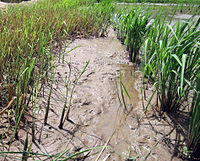
Photo from wikipedia
Phosphorus (P) budgets can be useful tools for understanding nutrient cycling and quantifying the effectiveness of nutrient management planning and policies; however, uncertainties in agricultural nutrient budgets are not often… Click to show full abstract
Phosphorus (P) budgets can be useful tools for understanding nutrient cycling and quantifying the effectiveness of nutrient management planning and policies; however, uncertainties in agricultural nutrient budgets are not often quantitatively assessed. The objective of this study was to evaluate uncertainty in P fluxes (fertilizer/manure application, atmospheric deposition, irrigation, crop removal, surface runoff, leachate) and the propagation of these uncertainties to annual P budgets. Data from 56 cropping systems in the P-FLUX database, which spans diverse rotations and landscapes across the U.S. and Canada, were evaluated. Results showed that across cropping systems, average annual P budget was 22.4 kg P ha-1 (range = -32.7 to 340.6 kg P ha-1 ), with an average uncertainty of 13.1 kg P ha-1 (range = 1.0 to 87.1 kg P ha-1 ). Fertilizer/manure application and crop removal were the largest P fluxes across cropping systems and, as a result, accounted for the largest fraction of uncertainty in annual budgets (61 and 37%, respectively). Remaining fluxes individually accounted for <2% of the budget uncertainty. Uncertainties were large enough that determining whether P was increasing, decreasing, or not changing was inconclusive in 39% of the budgets evaluated. Findings indicate that more careful and/or direct measurements of inputs, outputs, and stocks are needed. Recommendations for minimizing uncertainty in P budgets based on the results of the study were developed. Quantifying, communicating, and constraining uncertainty in budgets among production systems and multiple geographies is critical for engaging stakeholders, developing local and national strategies for P reduction, and informing policy. This article is protected by copyright. All rights reserved.
Journal Title: Journal of environmental quality
Year Published: 2023
Link to full text (if available)
Share on Social Media: Sign Up to like & get
recommendations!